Genre: RPG Developer: BlueSky Software Publisher: Sega of America Players: 1 Released: 1994
Shadowrun is an adaptation of a long running pen-and-paper RPG of the same name, whose setting is that of a cyberpunk world crossed with urban fantasy circa 2050, where magic has returned to the world and creatures of yore walk the land. Spellcasting Elves walk alongside shotgun-toting Dwarves and computer literate Trolls, with the remaining humans still trying to adapt to this change and to the ever-increasing potential of technology and the dangers of a world ruled by ruthless mega corporations. The title itself is a nod to the game’s most common activity: shadowrunning, which revolves performing covert jobs, or runs, for high-paying contractors.
The premise of the title is deceptively simple, although even in its meager beginnings there is some definite potential. The main character, Joshua, arrives in Seattle only to find out his brother Michael was ambushed and killed during a shadowrun, his death recorded and broadcasted in the national news. Finding out the reason for his death, as well as the identity of his assassin are the two main quests surrounding the game and will require a bevy of tasks to be completed, ranging from good old fashioned detective work to fast paced combat and completing dangerous missions. One of the highlights of the game is how the story gradually evolves, with a good amount of foreshadowing simultaneously rewarding the player for his persistence as well as teasing him to find out more about the story.
The main part of the game is spent looking at the action from a top-down angle, much like TechnoClash. In fact, if you’ve played that title before you may recognize much of the sprite, animation, and area designs are quite similar to those of Shadowrun. Even the real-time combat and three-character party system seem lifted from there. But that’s where the comparisons end – while TechnoClash was fairly colorful, Shadowrun is ultimately drab. It’s true that the source material is somewhat bleak but it seems the developers went the extra mile to make it even worse. Special effects and music are also poor and more of an afterthought. Because of this, the game lacks in the visual and audio departments and rarely compensates, ultimately suffering from a disjointed presentation. It’s good to know then, that there’s more to the game than this.
You can choose between three different classes for the main character: street samurai, decker, or shaman. The street samurai is the obvious choice for pure combat archetypes, with knowledge in combat tactics, and equipped with some subdermal spurs that inflict extra melee damage. The decker is Shadowrun‘s equivalent of real life hackers, data experts that mine global databases in search of profit or thrills, and access cyberspace (the world wide web of communications) neurally via a datajack, a cable that permits them to connect their brains directly into it. Lastly, a shaman is a spellcaster attuned to nature, using a totem that attunes them to a particular animal (in the case of Joshua, his token animal is a gator), and numerous trinkets that increase their magical aptitude.
Every player will have the chance to (mostly) develop the character as they see fit. A street samurai can also double as a decker, and a shaman can beef himself up to work as a secondary brawler; however, only shamen can use magic as they are the only ones who can use Sorcery. Still, this skill-based system is diverse enough to allow characters to expand several types of attributes and skills as they see fit. Also noteworthy is that most skills will have an actual use in the game world, and different levels of expertise will present different results. Trying to force open a lock on an electronic door with a poor skill in Electronics will quickly sound an alarm, while a higher skill level will silently open it and allow you to enter the room. The same applies to combat as well, with characters having a harder time using weaponry which they are not skilled with. This level of synergy between the character’s skills and their application in the game world makes it possible for a character, or group of characters to work out certain situations by relying on several of their abilities instead of having to follow a predetermined path or solution.
The system is not without its faults, though. Some skills aren’t fully developed and simply bloat the entire set. Reputation for instance, is a reflection of the character’s notoriety but is not dynamic; it only increases by spending points in it, instead of having it change based on situations like failing missions, killing Lone Star officers, or doing great feats that affected the game world. A more dynamic Reputation system would help dispel the sense that the character’s actions have no impact on the game world. Throwing is a waste of skill points because grenades are the least useful combat option available, and pistols simply pale in comparison to shotguns and SMGs. Also, considering the possibility of having party members tag along, there’s not much of a need to increase some skills since you’re likely to find someone who has what you need.
Unlike many console RPGs, Shadowrun uses a “point buy” system which enables characters to accumulate points which they can then distribute across their character sheet. This means that instead of giving out experience points to characters when they perform certain actions until they level up, characters in the game will receive and pool Karma points depending on what kind of missions they complete. When they have a necessary amount, they can spend them to improve their attributes and skills. Different abilities require a different amount of points, but thankfully, the character screen itself is easy to understand and contains all of this information, as well as telling you what a skill or attribute directly influences.
Life in Seattle is dangerous but, in another interesting departure from its RPG contemporaries, you can hire shadowrunners for single jobs or for the long term. Hiring them for single jobs is a good way of working up on your earlier forays into the game, but the long term is how you properly begin to assemble a team. Shadowrunners hired in this manner won’t leave you unless they fall in combat, at which point they’ll leave the party and you need to hire them again – with an added Nuyen (the game’s currency) penalty for having been such a lousy squad leader. This may happen every once in a while, since party members controlled by the game are not exactly stellar. To alleviate this problem somewhat, the developers allow players to fully control party members as well, with a simple tap of the C button letting you cycle between members.
Some of the mercenaries have a distinct advantage over the competition in terms of attributes or skills, but the truth is they all can be developed to their max potential and save the often negligible statistical difference, they generally play the same. Unfortunately, save for their introduction and a bit of background, they’re extremely underdeveloped and will simply act as cannon fodder for the rest of the game. Which is a pity since some of them, like Winston Marrs, the surly and brutal Troll samurai, would really benefit from more character exposition. All of the racial tension and dichotomies between magic and technology present in the *Shadowrun* setting could provide some interesting and amusing exchanges between party members, and their absence is a definite minus. At least the main character has a shred of personality, in part thanks to the ability to manifest himself during some dialogue options across the game, but he won’t charm anyone with his “chummer” routine.
With or without mercenaries, you’ll eventually need to perform shadowruns which double as your main source of character advancement and monetary rewards, as well as providing some of the most unique moments in the game. There are various types of runs, which vary in terms of complexity and actual play style. For instance, bodyguard runs require you to meet up with a client in a location and bring him unharmed to another, while courier runs require you to deliver packages instead. Other runs involve hunting for ghouls (humans mutated by a worldwide virus), retrieving stolen packages, or extracting disgruntled employees from well-protected corporation buildings. Cyberspace also ties into corporate runs. When inside a corporation, you can access the corp’s own cyberspace structure and manipulate it to your needs. Need to shut down cameras? Deactivate the surveillance node in the system. Need to open locks? Bring down the security node. Maybe you want to enable complete floor access through elevators? Work your way into the elevator slave module. Or just collapse the main CPU and render the corporation impotent for a short while.
Their difficulty depends on how good your character is and to what particular Johnson you talk to. Taking on a corporation run with a poorly developed character is simply a bad decision, and players should usually be able to discern just how tricky a mission can turn out to be by judging from the payment offered. To avoid runs getting stale they are all randomly generated, with the game drawing from a pool of information to randomly dictate the places, goals and payments of a run. It works to a point: you’ll initially appreciate the feel that there are no to similar runs but after a while it tends to repeat or work against the very gameworld. In one instance you may be tasked with escorting one character from point A to B, but you’ll wonder just why someone needs to be escorted across the street. You’ll also find situations where you’ll be tasked with beating up a local gang, but you’re given the job of fetching a package from them right after, and when you visit them, they’ve all but forgotten you’ve killed five of their members minutes ago. Other times you’ll seemingly receive a string of runs with the same goal set in the same location when the game could have just assigned multiple runs in a single location instead to make it more varied and challenging. Later into the game, these problems and their repetition becomes all too evident.
One of the major points of the setting is cyberspace, or the Matrix – a consensual hallucination meant to represent the global computer network where disembodied consciences float across its data streams – which only those equipped with a datajack and a cyberdeck can access. A cyberdeck is roughly the equivalent of a laptop computer and serves as a two-way channel between a character’s datajack and the Matrix. Whether you’re logging in just for fun or to do a matrix run, whenever characters access the Matrix the game shifts to a different perspective and style of gameplay. While in cyberspace, only one character (the one who jacked in) will be available, and the game will go from a top down perspective into a third-person view, where a silver representation of a humanoid figure glides across the data streams. Combat also changes, with attacks being made with software programs you can purchase to defeat electronic countermeasures created to defeat intruders. You can attack and destroy the nodes so you can pass, attempt to disguise yourself as a bit of innocuous information, rebound the systems attacks against itself, and so on. Cyberspace in itself is almost an entirely separate game.
Still, it’s unfortunate that all of these fun elements aren’t good enough and the game eventually becomes too repetitive in the long run. The problem is that Shadowrun succeeds in translating some of the main aspects of the source material but fails to carry them into greater heights. The gameplay is technically sound but is too centered around doing the same tasks over and over again; while other games are also guilty of this they manage to alleviate it by providing other gameplay nuances to reduce this factor. Shadowrun just tosses all these great concepts and gameplay elements but limits their scope and in the end, players looking for the next step in the formula’s addiction will find nothing else.
While by no means a perfect rendition of its source material, the Genesis version of Shadowrun is much closer to its pen and paper roots than its SNES counterpart or any other current videogame in existence. The main problem when adapting a pen and paper RPG system to a computer or console game is the fact that these platforms are extremely limited by comparison.
Shadowrun is only a few steps away from realizing its true potential but what is there is very recommendable. It’s definitely a good RPG experience that all Genesis owners should try at least once. Highly recommended for those willing to try something different.
SCORE: 7 out of 10


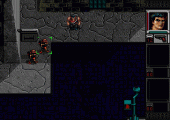
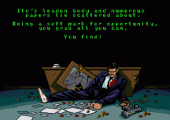
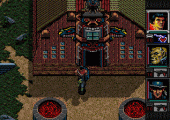
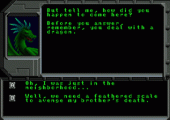
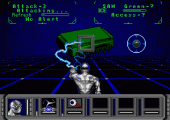
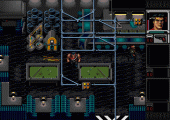
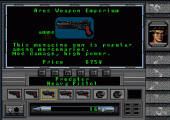
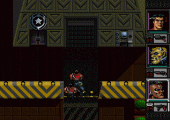
Here’s my review: It’s awesome!!!!
Protip: Always play a Shaman. Thanks to the Karma system you can turn a magic user into a Street Samurai, or a Decker, but you can’t give another class magic. Even if you boost your cyber-ware to the maximum level you will always be able to cast level one spells, which work great on unsuspecting pedestrians. Why waste bullets collecting extra ammo and first aid kits? Happy fragging chummers.
Oh awesome! Good tip. I always go Samurai, I’ll try Shaman next time 🙂